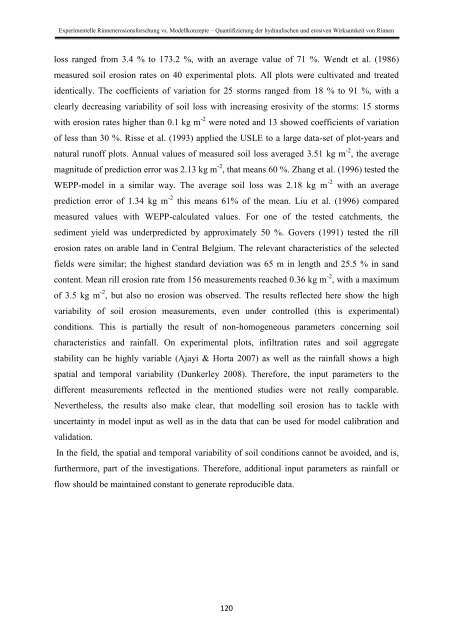Stefan Wirtz Vom Fachbereich VI (Geographie/Geowissenschaften ...
Stefan Wirtz Vom Fachbereich VI (Geographie/Geowissenschaften ...
Stefan Wirtz Vom Fachbereich VI (Geographie/Geowissenschaften ...
Create successful ePaper yourself
Turn your PDF publications into a flip-book with our unique Google optimized e-Paper software.
Experimentelle Rinnenerosionsforschung vs. Modellkonzepte – Quantifizierung der hydraulischen und erosiven Wirksamkeit von Rinnen<br />
loss ranged from 3.4 % to 173.2 %, with an average value of 71 %. Wendt et al. (1986)<br />
measured soil erosion rates on 40 experimental plots. All plots were cultivated and treated<br />
identically. The coefficients of variation for 25 storms ranged from 18 % to 91 %, with a<br />
clearly decreasing variability of soil loss with increasing erosivity of the storms: 15 storms<br />
with erosion rates higher than 0.1 kg m -2 were noted and 13 showed coefficients of variation<br />
of less than 30 %. Risse et al. (1993) applied the USLE to a large data-set of plot-years and<br />
natural runoff plots. Annual values of measured soil loss averaged 3.51 kg m -2 , the average<br />
magnitude of prediction error was 2.13 kg m -2 , that means 60 %. Zhang et al. (1996) tested the<br />
WEPP-model in a similar way. The average soil loss was 2.18 kg m -2 with an average<br />
prediction error of 1.34 kg m -2 this means 61% of the mean. Liu et al. (1996) compared<br />
measured values with WEPP-calculated values. For one of the tested catchments, the<br />
sediment yield was underpredicted by approximately 50 %. Govers (1991) tested the rill<br />
erosion rates on arable land in Central Belgium. The relevant characteristics of the selected<br />
fields were similar; the highest standard deviation was 65 m in length and 25.5 % in sand<br />
content. Mean rill erosion rate from 156 measurements reached 0.36 kg m -2 , with a maximum<br />
of 3.5 kg m -2 , but also no erosion was observed. The results reflected here show the high<br />
variability of soil erosion measurements, even under controlled (this is experimental)<br />
conditions. This is partially the result of non-homogeneous parameters concerning soil<br />
characteristics and rainfall. On experimental plots, infiltration rates and soil aggregate<br />
stability can be highly variable (Ajayi & Horta 2007) as well as the rainfall shows a high<br />
spatial and temporal variability (Dunkerley 2008). Therefore, the input parameters to the<br />
different measurements reflected in the mentioned studies were not really comparable.<br />
Nevertheless, the results also make clear, that modelling soil erosion has to tackle with<br />
uncertainty in model input as well as in the data that can be used for model calibration and<br />
validation.<br />
In the field, the spatial and temporal variability of soil conditions cannot be avoided, and is,<br />
furthermore, part of the investigations. Therefore, additional input parameters as rainfall or<br />
flow should be maintained constant to generate reproducible data.<br />
120
















